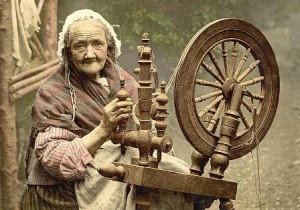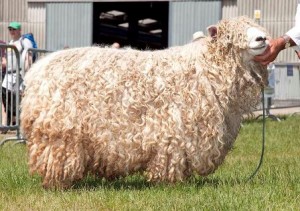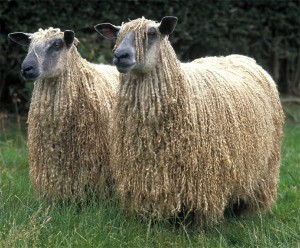
Back in December, I talked about knitting: the significance of knowing – at least rudimentary – how to make your own, and the paradox of us wanting ‘unique pieces’ of art and craft while only being prepared to pay a price for them that is dictated by a completely unsustainable mass-market.
In this post, I’d like to look into how the mass manufacturing supply chains, production ethics, and business models affect even a simplistic task: Buying a small quantity – around 500 grams (~ 1lb) of knitting/ weaving yarn – for my next hobby project.
First of all it has to be said that I can’t normally bare man-made fibre on my skin. Hence, given that I’ll be using my hands for either knitting or weaving, these are a NoNo. Interestingly, this side condition weeds out already most yarns available a) for cheap or low prices and b) the majority of yarns available easily and without further ado in high street haberdasheries. I would estimate that a whopping 80% of knitting yarns available in a department store are mixes which more often than not contain a good percentage of acrylic, which usually serves to make them more ‘elastic’ and easier machine washable. It’s less of a problem for weaving yarns it seems, however.
That yarn-based hobbies are back in popularity is indisputable. The haberdashery sections in the world’s largest cities boast vast ranges and colour gamuts of yarn, which – commercial budgeting and calculation to be thanked – is only be the case if the generated bottom line profits are generous enough. Small specialised knitting and crochet yarn shops are popping up at every street corner, or so at least it seems, and Etsy – “the world’s most vibrant [online] handmade market place” – is brimming with hobby spinners and dyers selling the fruits of their labour.
‘Self-made’ is no doubt back in fashion. With one key difference however: We now knit, sew, weave, embroider and crochet not because we have to, but because we enjoy doing it. Making a living from either of these skills is in the present day and time close to impossible.
But back to my original task: buying a small quantity of yarn for a knitting project.
First of all, no matter where one goes to buy yarn, it’s difficult to find some that is not produced by the ‘big’ industrial brands, British or otherwise. Those yarns certainly feed the mainstream, but from a creative perspective they have rather poor profile: Large batches of ‘all the same’, colours that please but don’t excite, textures that are everything but pleasant to touch and that tell the story of industrial manufacturing. And: they are despite being manufactured in large quantities and high-tech facilities, everything but cheap.
Once that I’ve weeded out all the yarns containing man-made fibres, I’m nearly always left with one or several of the following yarn options:
- Cotton: generally non-organic, hence due to it’s environmental and human-rights footprint a definite NO in capital letters as far as I’m concerned.
- Wool: normally sold without further indication of origin, which again means it is Australian or New Zealand wool. This makes it a NO due to: not being organic, large carbon footprint, the lack of a properly traceable supply chain altogether, and widely practised mulesing
- Merino wool: see previous point
- British wool: normally a side product of the meat industry, and therefore in all but a few cases non-organic, mostly from non-native breeds whose fleece is second to better suited breeds bred for their wool.
- Silk: putting aside the fact that it is difficult to find silk yarn suitable for knitting, this would be one of the better options. Lack of traceability, and the use of industrial dyes remain though a problem.
In short, I’m left with a whole range of questions such as:
- Where is the variety in yarns we know exists? Examples are: Hemp, nettle fibres, organic cottons, non-viscose bamboo (i.e. produced using mechanical a retting process instead of chemical enzymes), camelid fibres (such as Alpaca and Guanaco), British wool from rare breads that are renowned for their quality wool, yak wool, peace silk, ramie etc. I’ve yet to find somewhere to come across even a limited number of them in acceptable quality and ‘nice’ colours.
- While the fibre content in each yarn is indicated in percentages, there is no indication however – neither for natural nor man-made fibres – of the types of dyes used, and neither of the softening and finishing chemicals applied.
- With the exception of a selected set of insider-yarns, none of the yarns have an indication of a) where they have been produced nor b) where the fibre originally stems from (which normally is not the same country, and in any case with high probably neither Europe, or the UK for that matter).
- There is almost never an indication where the yarn has been produced, i.e. which manufacturer was responsible for turning fibre into yarn.
- There are not normally care instructions printed on the sleeve of the yarn. If they are, it usually reads ‘hand wash’, which is not in all imaginable cases appropriate (think of knitwear used and worn by babies).


Considering how many balls and skeins of knitting yarn are being flogged off during the official sales periods alone, a little more awareness and a slightly more critical mind set among us hobby knitters would go a far way to change parts of the world yarn supply chains. Imagine, if every knitter in the UK, or Europe or the US for that matter, would require their yarns to be dyed with natural dyes only, that they be at a bare minimum organic, or that instead of Australian and Kiwi Merino it be British wool, of which every 10th ball stem from a rare breed sheep species such as the ‘Wensleydale‘ or the ‘Devon & Cornwall Longwool‘.
Now, where to look for better alternatives? For the interested, here a small list of yarn producers that not only produce gorgeous yarn, but also contribute their bit in making the world a better place:
- Manos del Uruguay [Uruguay]. Website: http://www.manos.com.uy/. Established in 1968 when a group of women in Uruguay was trying to find way to promote social and economic development in rural areas. This was the start to possibly the first producer of ‘ethical’ yarns – all hand processed from start to finish by women in poverty ridden rural areas of the country.
- Mirasol Yarns [Peru]. Website: http://www.mirasolperu.com/. The Mirasol Project supports local communities in Peru through the sales of the Mirasol Yarn Collection. The collection includes yarn made from the animals tended by these communities for generations in the Peruvian highlands.
- Araucanía Yarns [Chile]. Website: http://www.araucaniayarns.com/. Araucanía Yarns is a group of artisans and designers dedicated to the artisan dyeing of fibers for weaving and knitting located in Santiago, Chile, on the southwest corner of South America.
- Mango Moon Yarns [Nepal, Indonesia]. Website: http://www.mangomoonyarns.com/. They work with the Nepali Women’s Empowerment Group and a spinners’ co-op in Indonesia to create yarns that are colourful and fun, and that help improve the lives of the artisans who spin it.
- Adventure Yarns [Tajikistan]. Website: http://www.adventureyarns.com/. Adventure yarns is the social enterprise that started in 2009 as a project managed by ICARDA and funded by IFAD. Their objective is to assist Tajik farmers to produce quality Angora and Cashgora goats and work with spinners and knitters to produce luxury mohair and cashgora yarns and knitted products for export.
- Malabrigo yarns [Uruguay]. Website: http://www.malabrigoyarn.com/. Malabrigo is a small, family owned yarn company located in Uruguay, the foremost wool producer country of South America. They work closely with a cooperative of women from Uruguay, and have developed a line of hand painted yarns natural fibre of incredible softness and wonderful colour variations.
- Ardalanish [UK]. Website: http://www.ardalanishfarm.co.uk/. Ardalanish is a small weaving company located in the South of the Isle of Mull in Scotland. They have their own flock of organically bred Hebridean and Shetland sheep, and also sell 500 gram cones of undyed knitting yarn in their online shop.
- The Natural Dye Studio [UK]. Website: http://www.thenaturaldyestudio.com/. They exclusively uses historical plant dyes, with the aim to produce desirable luxury yarns in as ethical and environmentally friendly way as possible. Their wools are licensed by the British Wool Marketing Board to carry the British Wool mark, and their exotic yarns come from a family run mill in Peru.
- Toft Alpaca Shop [UK]. Website: http://www.thetoftalpacashop.co.uk/. Toft is an Alpaca breeding farm based in Warwickshire. They breed their own flock of Alpaca, and separated the fleeces after shearing into the 22 naturally occurring shades, which then can be bought, amongst other, as knitting yarn. All of their UK products (all yarns, hats and handbags) are made in 100% natural British alpaca, undergoing minimum contact with chemical processing. All of their hand-knit yarns for retail are spun in the UK and are, so they say, ecologically and ethically sound.
- ColourMart [UK]. Website: http://www.colourmart.com/. Colour Mart is an online supplier of remainder luxury yarns, particularly cashmere and silk. They source their yarns from Scottish and Italian mills and then package them to suit the needs of hand and machine knitters, weavers, hand dyers etc.
- Eco Fairtrade Collection by Debbie Bliss. Read information. These yarns are manufactured from organic cotton within an ecological and socially conscious process through the bioRe textile chain, which integrates farmers, their families and the textile industry as equal partners. Widely available in high street haberdashery departments.

